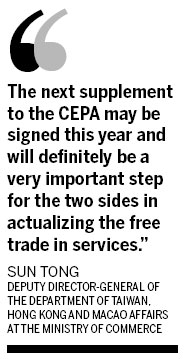Agreement with HK likely to try out 'negative list'
By Li Jiabao (China Daily) Updated: 2014-01-24 07:33
The trade agreement between the mainland and Hong Kong probably will try out the "negative list" approach, and free trade in services between the two sides likely will be accomplished by 2015, a senior commerce official said Thursday.
"As for the 'negative list' or the 'pre-establishment national treatment', they can be choices for the Closer Economic Partnership Arrangement between the mainland and Hong Kong. But the two sides need to reach consensus before putting the approaches into practice," said Sun Tong, deputy director-general of the Department of Taiwan, Hong Kong and Macao Affairs at the Ministry of Commerce.
"This shows the government's determination in terms of opening up, but the progress needs to be coordinated with the investment negotiations with the United States and the European Union," said Zhuang Rui, deputy dean of the Institute of International Economy at the University of International Business and Economics in Beijing.
The "negative list" specifies bans and restrictions on types of foreign investments, and "pre-establishment national treatment" gives foreign enterprises the same treatment as domestic companies.
The approaches are currently being piloted in the China (Shanghai) Free Trade Zone and have been adopted in the country's bilateral investment treaty negotiations with the US and Europe.
China pledged to introduce unified market access, and all market players will be allowed to equally enter domestic sectors outside the "negative list", according to a reporter at the Third Plenary Session of the 18th Central Committee of the Communist Party of China.
"The next supplement to the CEPA may be signed this year and will definitely be a very important step for the two sides in actualizing the free trade in services," Sun said. "There shouldn't be any problem in both sides reaching the goal of free trade in services by 2015, but sensitive sectors relating to national security must be advanced prudently."
The two sides agreed to actualize free trade in services by 2015, and the mainland has opened 93.1 percent, or 149 sectors, of the 160 services sectors to Hong Kong. Tariffs on merchandise trade were removed in 2006.
A total of 10 supplements to the CEPA were signed between the central government and the Hong Kong Special Administrative Region. CEPA, signed on June 29, 2003, aimed to forge closer ties between Hong Kong and the mainland. The pact covered trade in goods, trade in services, and trade and investment facilitation.
Sun noted that CEPA represents the highest level of free trade agreement that the mainland has inked with any economy.
"The ministry supports the initiative of establishing a free trade zone covering Guangdong province, Hong Kong and Macao, which will feature the mainland's ties with the regions and make use of the regions," Sun said.
He noted that the central government also supports Hong Kong's negotiations with ASEAN for an independent regional economic agreement.
Trade between the mainland and Hong Kong in 2013 rose 17.5 percent year-on-year to $401.01 billion, about 9.6 percent of the mainland's total.
The mainland's exports increased 19 percent to $384.79 billion with imports dropping 9.3 percent to $16.22 billion, Sun said.
In 2013, Hong Kong's direct investment in the mainland, not including financial sectors, rose 9.86 percent year-on-year while the mainland's investment in Hong Kong fell 6 percent, according to the ministry.
- NHTSA says finds no 'defect trend' in Tesla Model S sedans
- WTO rare earth ruling is unfair
- Amway says 2014 China sales may grow 8%
- President Xi in Europe: Forging deals, boosting business
- CNOOC releases 2013 sustainability report
- Local production by Chery Jaguar Land Rover this year
- Car lovers test their need for speed in BMW Mission 3
- China stocks close mixed Monday







